The information presented in this publication is collected by ICT through various direct sources from Tibet.
DECEMBER 9, 2014
Tibetans prioritise protection of their language
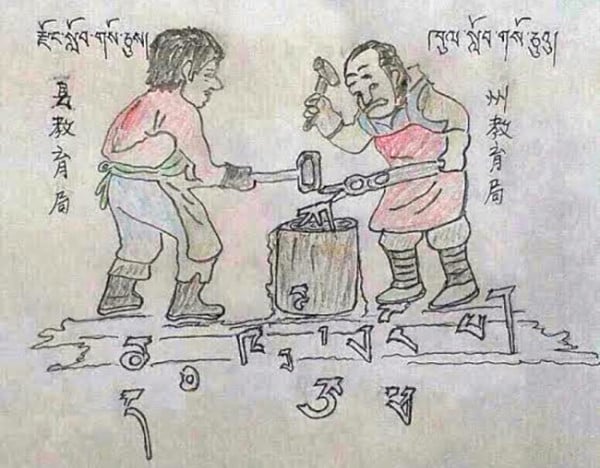 This cartoon, which is circulating on social media, depicts blacksmiths at a forge hammering out characters from the Tibetan alphabet, distorting and breaking them. The Tibetan and Chinese on the left says: ‘county education bureau’ while above the man on the right, the characters read ‘prefecture education bureau’, implying that the two levels of authority work together in undermining the Tibetan language.
This cartoon, which is circulating on social media, depicts blacksmiths at a forge hammering out characters from the Tibetan alphabet, distorting and breaking them. The Tibetan and Chinese on the left says: ‘county education bureau’ while above the man on the right, the characters read ‘prefecture education bureau’, implying that the two levels of authority work together in undermining the Tibetan language.
The cartoon, posted by Tibetans from the eastern area of Amdo, reflects concern about new measures that focus on Chinese as the main language of instruction with the Tibetan language to be treated only as a language class, and with less time allocated to it in the curriculum. The Qinghai authorities’ have emphasized the importance of the Chinese language for Tibetans, which strikes at the core of Tibetan fears over the survival of their identity and culture.
Even so, Tibetans from Amdo testify to the resurgence in efforts by a younger generation of Tibetans to protect their language. A Tibetan from Amdo said: “Tibetans have been talking a lot about these initiatives. Recently, there was the major development that major banks adopted the use of Tibetan as well as Chinese language on ATM machines in some areas of Qinghai. This was really welcomed. There are many local schools in the areas of Golog (Guoluo), [Amdo]; Kardze and Serthar [in Sichuan, the Tibetan area of Kham] where pupils will check logos and signboards above shops or businesses, and they will make sure the Tibetan is correctly written. They also challenge the language used in advertisements – this is cooperative work, based on the efforts of volunteers, people who really care about their language. Tibetans are also openly expressing their concerns to education departments in different areas.”
The same Tibetan mentioned that Tibetan intellectuals had marked the anniversary of the death of poet Yidam Tsering, one of the most influential thinkers and writers in modern Tibet, who died in October, 2004. Yidam Tsering was a strong advocate of Tibetan language and culture and is revered in a similar manner to the poet Dhondup Gyal, regarded as the founder of modern Tibetan poetry and who committed suicide in 1985 at the age of 32. The Tibetan intellectual from Amdo said: “Even though Yidam Tsering wrote in Chinese, you can feel the strong Tibetan spirit. Tibetan students and writers held memorial services for him in October in order to honor him as a source of inspiration.”

DECEMBER 1, 2014
An experience of hard labour in detention after trying to escape
A young Tibetan nomad woman in her late thirties told ICT about the reasons for her escape into exile – Chinese policies on settlement that were ending the nomadic way of life in her area of eastern Tibet. She arrived in India on her second attempt to escape into exile. Her first attempt, several years ago, was unsuccessful, and she relates her experience after reaching the border with Nepal.
“I was caught by police when I was quite close to reaching the border with Nepal, that first time I tried to leave for India. I was travelling with a group of six of us from my village, including two children. But we were stopped and arrested by People’s Armed Police border security at a checkpoint. They took us to a local border security headquarters in Purang [(Chinese: Burang) county in Ngari prefecture, the Tibet Autonomous Region]. There, they started to question us separately, and we were all kicked and punched by the soldiers.
“After five days in detention, we were transferred to the county police detention center. They locked me up in a solitary cell with both my arms and feet shackled. I was kept there for some days. Then I was transferred to the police station for seven days, and then taken to a labor re-education camp.
“When I was in a solitary cell at Purang county police detention center, it was so tiny that only one person could fit inside it and move around a bit. But later on, at the re-education camp, it was much worse because the cell was totally dark. I could not see a thing. I was locked in there on my own for a few days. I have no idea why they left me in there – later on, other prisoners told me that prisoners could not survive much time in that cell. They said that even if a prisoner was healthy beforehand, if they spent a month in that cell, they might lose their mind.
“It was very normal to be beaten and tortured in detention. Sometimes when they were interrogating me the police beat me with electric batons and belts. Later on I could feel nothing because I lost all sensation in my body. Several times I lost consciousness, I think this was when they used electric batons and gave me shocks. When I was lying on the floor they would kick me. When I regained consciousness I would find myself again handcuffed in a cell alone. One day at the labor camp they locked me up alone without any food or water. Once they hung me up by my arms for a whole night from the ceiling.
“At the beginning of my sentence, they told me that my thinking should be reformed through labor, this is what re-education through labor means. So I had to do a lot of hard work, carrying stones and bags of sand. Two or three armed Chinese guards would follow us to supervise our work and sometimes in the fields outside the labor camp.
“Sometimes, when we felt so sick that we were unable to move, the guards at the camp registered that we were absent from work. This affected our overall record in the camp and we knew that if we missed too many days we might have to stay longer. After a year, of hard work every day with poor food, my health got worse and worse. I got really sick and felt I was close to death. I was released from the camp then, I think because the Chinese authorities were worried that I might die in prison. They summoned my relatives to prison and they had to sign a document guaranteeing that I would not get involved in any activities that are against the law.
“After I was released my parents took me to hospital, where I stayed for a few months, and when I went home again, the labor camp officials still came to visit my family to check up on me. After a few years, I was finally able to safely escape again into exile in India.”
The Yak’s Arrest
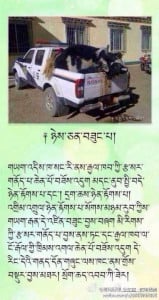
“Criminal Arrested
“This yak had caused tremendous damage to the country’s grassland on the mountain yesterday. Last night, the Public Security personnel, the Armed Personnel, and travel security personnel have worked together to arrest this old yak. It had committed grave violation of the rules demonstrating against the Party and the Country, by damaging the grassland of the nationalities. Today, after deliberating on this issue by the office, it is said that death sentence will be issued.”
A Tibetan from Amdo said: “This yak was arrested by the Communist Party authorities. A large armed policy force was deployed to arrest the yak in the grasslands, where he was eating his dinner. A local person said that the yak was arrested at around 8 pm last night without any further explanation, and later the local authorities informed herders that the yak had illegally eaten grass from a restricted area of land. They said the land was restricted by local officials for a picnic next summer and that the charges against the yak were ‘destruction of Communist property’.”
Another Tibetan from the area said: “This is land which historically belongs to the community; we have been living here for generations. But today the Chinese Communist Party says it is their land and have taken it by force.”

NOVEMBER 3, 2014
A Tibetan monk talks about the impact of policies and patriotic education on his monastery
A Tibetan monk from Nagchu (Chinese: Naqu) in the Tibet Autonomous Region, who is now in exile, gave an account of how Chinese policies affect life in his monastery since protests swept Tibet in 2008.
“I had been in my monastery for more than seven years, and I studied mainly by reciting and memorizing Tibetan Buddhist texts. I gained a profound realization about Buddhism and its approach of love and compassion. In our monastery, we had to undergo sessions of ‘patriotic education’ – the terminology has now changed to ‘legal education’. At first, the official work team who were teaching us ‘patriotic education’ was at the monastery for two or three days every month. They emphasized that we had to dissociate ourselves completely from any allegiance to the Dalai Lama. We also had to write statements giving our experience and what we had learned during the campaign. The officials always emphasized that monks should ‘love our country and love the Communist Party’ as a prerequisite to being a Buddhist practitioner. The frequency of patriotic education sessions increased after 2008 [when a wave of unrest swept across Tibet].
“The Tibet Autonomous Region used to give funding to the monastery if there were no political activities – for instance as long as monks did not protest, and there were no leaflets about independence or freedom. But one year two monks were sentenced on charges of ‘separatism’. Another time, the local authorities deployed armed police and officials at the monastery and gathered all the monks together to sign a document [promising there would be no political activity]. I was told that one young monk, who was probably around 15 or 16 years old, tore up the document and threw it away. He disappeared and has never been seen again; I still don’t know where he is.
“The Tibet Autonomous Region authorities have a scheme to give rewards to the ‘Best Socialist Buddhist monastery’. If any political activities have taken place at the monastery, then there is no possibility they will win the award. Nowadays, the local authorities have installed a government official permanently in monasteries, observing the situation. Traditionally, we would be able, and it is important for us monks, to study at other monasteries. For instance I wanted to study at a monastery in my home area in Amdo. But now there are a couple of checkpoints with armed police between my monastery and Amdo, and we have been instructed not to travel there by the officials.
“When I used to go home to Amdo and to the monastery there, I learnt a lot more about the self-immolations among Tibetans who had sacrificed their lives for freedom and for the return of His Holiness the Dalai Lama to Tibet. In the Tibet Autonomous Region, our only source of information about these things was by word of mouth. Tibetan language services of Voice of America and Radio Free Asia [that broadcast into Tibet] cannot [generally] be heard in the Tibet Autonomous Region,[1] and it is too risky for us to speak about His Holiness unless there is a really deep trust between individuals doing so.”
Footnote
[1] This was the impression of the interviewee; while the Chinese authorities are jamming these radio broadcast in Tibet, it is likely that in some areas they are able to listen.

OCTOBER 24, 2014
Vibrant initiatives to protect Tibetan culture evidence of deepened solidarity
A Tibetan from the eastern Tibetan area of Amdo who travelled into exile recently told ICT about the diverse efforts made by Tibetans since the crackdown in 2008 to protect their culture, religion and national identity. They are indicative of the sense of solidarity and unity among Tibetans across the different regions of Tibet as they cope with intensified militarization and a shrinking space in which to express themselves.
The Tibetan from Amdo said:
“Since 2008, after the initial severity of the crackdown, in our area many small organizations and groups have been established focusing on language, environment, literature, poverty, healthcare and others. Many are informal groups and they give small donations themselves, for instance to support disabled local people. Many of these groups initially approach respected religious teachers and lamas to establish their work, and those teachers then help to guide the work of the organizations. In one area there is a group of individuals who recite mantras for the long life of the Dalai Lama, in another there is a group of elderly people who give free Tibetan language teachings to children. Other Tibetans work on updating Tibetan vocabulary to reflect contemporary usage as well as motivating people to speak the pure Tibetan language.
“I heard of another organization, formed by both young and elderly women in some nomadic and rural areas who do fasting and prayers for the long life of His Holiness the Dalai Lama and other religious masters. There are many groups involved in environmental protection, too; some of them raise awareness of the importance of stopping environmentally destructive activities such as mining or deforestation, and others travel to monasteries and towns to do recycling, clearing waste from rivers, working with schools and monasteries. And then there are health care groups – some Tibetans work hard translating and publishing books with health guidelines and advice about such things as AIDS/HIV and tuberculosis. All these organizations are working very hard in Tibet and are established by many warm-hearted Tibetans. While these are small groups, and highly focused on these basic, non-political activities, they represent a huge contribution to Tibetan society. In 2008, Tibetans came out onto the streets in their thousands, across Tibet, to protest Chinese rule, without any organizational leadership – the protests were spontaneous and not orchestrated. In order to ensure the future of their culture and religion, despite the obstacles, now the Tibetan people really have to prepare for their future and protect their language and culture.”

OCTOBER 10, 2014
A meeting in prison
A Tibetan in his twenties from Kardze (Chinese: Ganzi) in the Tibetan area of Kham, was imprisoned for a year and a half following his involvement in a peaceful protest in 2008. He recalls his experience in prison.
In addition to being separated from his visiting mother by a glass screen during the monthly visits, there were further restrictions on language –Tibetan prisoners and their visitors are compelled to speak in Chinese, which deepens their anguish and often makes it impossible to communicate, particularly when the visitor is from an older generation and unable to speak Chinese.
The Tibetan recalls,
“Prison regulations were for the prisoners to be able to receive visits from friends and family once a month. The official language to be spoken at these visits was Chinese. My family was unable to see me several times when they arrived at the prison because they could not communicate with officials at reception.
“When we met our visitors, we were separated from them in a room completely sealed off by glass, we could see them but not reach them physically. The conversation has to be done through phones on either side of the glass screen, and we were allowed to speak for 15 minutes each month. My family spent a lot of money in travelling a long way from home to the prison for these 15-minute conversations with me. The prison authorities did not allow us to accept food and clothes from our visitors.
“Another difficulty was that all of our conversations were taped by the prison officials. Sometimes, details in the conversations would be followed up by officials from our home area, for further investigation. So I was always very nervous and uncomfortable to say almost anything, for fear that I might be penalized later, or my family, even for something that was innocent but interpreted in the wrong way.”
In general, “The food in prison was very simple; rice porridge and steamed bread for breakfast, rice and fried vegetables for lunch and then again rice and vegetable with soup for dinner. The food was very watery, not rich at all. Due to this weak food combined with hard labor day after day, it was very hard to prevent illness, and often we felt dizzy and kept vomiting. But you had to carry on with hard labor until you literally collapsed and could not get out of bed.”

SEPTEMBER 19, 2014
New checkpoints create tensions and distress in Driru
Four new police checkpoints have been established between the restive area of Driru, which is under a harsh crackdown, and other areas of Nagchu in the Tibet Autonomous Region, according to Tibetans.
The checkpoints are causing much distress – even Tibetans going to hospital for emergency medical treatment have been stopped and delayed. A Tibetan in contact with others in the area said: “The attitude of the police manning the checkpoints is so aggressive that drivers and passengers of vehicles have been arbitrarily beaten up, and some even detained and compelled to undergo ‘re-education’ for periods of 15 to 20 days. Some have been fined large amounts, accused of vague offences against for instance ‘social stability’. In the past, local people and travellers enjoyed this route across the landscape of the high plateau, but now there is an atmosphere of fear and tension due to the militarized checkpoints and paramilitary presence.”
The new checkpoints, which are manned by paramilitary police 24 hours a day, have been set up in Driru (Chinese: Biru) in Nagchu (Chinese: Naqu) prefecture as part of a systematic operation to tighten security in the area and monitor both local travellers as well as visitors from outside the area. There is a deepening crackdown in Driru and a new wave of oppression involving the sentencing of numerous Tibetans to long prison terms. Despite the harsh measures, thousands of Tibetans in Driru held a peaceful, reasonable protest against mining at a sacred mountain in May. It was broken up by troops, and ring-leaders detained and sentenced. (RFA report, Thousands of Tibetans Protest Against Mine).

AUGUST 25, 2014
How China’s urbanization policy impacts Tibetan nomads
A Tibetan nomad in her late thirties who escaped into exile recently spoke about the dramatic changes to nomad life due to Chinese policies imposed in her home area in Ngari (Chinese: Ali) in Western Tibet since 2005.
As part of a sweeping policy of urbanization, the authorities compelled nomads in Ngari to abandon their homes and traditional nomadic tents for new permanent brick houses in a ‘socialist new village’.[1] The nomad told ICT: “In the summer, we used to move our herds over vast distances, grazing our animals on rich grasslands; and in the winter time we could also travel to other places to sell our products like butter, meat and animal skins. In the winter we lived in a mud and brick house, and in the summer a black tent [made of yaks’ hair]. We would go on pilgrimage and our elders would take the children into the grasslands to tell them stories about old Tibet. We didn’t want to move to one of the ‘comfortable’ houses but had to do it.” After the nomads moved in, they discovered that the houses were so poorly constructed that within two years the walls had begun to crack.
The nomad told ICT: “The grasslands were divided up, but the area of land that we were allotted was insufficient for our animals. This led to fights among families. Also, there was a quota of the number of yak, sheep, horses, goats and other livestock, which each family may own. If we kept livestock beyond our quota, we had to give the government all those animals as a punishment.
“As we are nomadic people, we traditionally treat livestock well and keep it for generation to generation. Yes, we would kill animals to meat, but no one would slaughter more animals than they could eat [in order to sustain themselves]. There are so many stories handed down through the generations of the good relationship between nomads and animals. But now we have to slaughter the animals beyond our quota, and sell them, but it hurts us. We feel we are no longer nomads but slaughterers.”
Footnote
[1] Hundreds of thousands of Tibetan nomads have been required to slaughter their livestock and move into newly built housing colonies (often called ‘comfortable housing’) in or near towns, abandoning their traditional way of life. ICT report: https://savetibet.org/un-special-rapporteur-warns-of-consequences-to-nomad-settlement/

AUGUST 21, 2014
The devotion of Tibetan and Chinese pilgrims to the Dalai Lama
Unlike past years, last month when the Dalai Lama bestowed the Kalachakra, a major religious empowerment, in Ladakh, less than 600 pilgrims from Tibet were able to attend. One Tibetan monk was only able to attend the teachings due to Chinese sponsors, who helped him to obtain a passport. Due to the sensitivity of Ladakh as a border area, the pilgrims from Tibet were under close watch by the Indian authorities.[1]
A Tibetan who was in Ladakh said: “I met a number of Chinese Buddhists from the mainland, not overseas Chinese, at the Kalachakra. Not all of them wanted to discuss anything about being at a Dalai Lama teaching, but their devotion was so evident. One Chinese woman told me that it was a very high priority in her life to attend the teaching. Also, some Tibetans told me that even though they knew they faced possible political problems upon their return, they felt strongly that the need to be in Ladakh for the Kalachakra outweighed the risk.”
Footnote
[1] ICT report on restrictions on travelling to the Kalachakra in 2014, and the shift in approach since the Kalachakra in Bodh Gaya, India, in January 2012: https://savetibet.org/china-tightens-control-prevents-pilgrimage-before-major-dalai-lama-teaching-in-exile/.
Posing at the Potala, and the shadow of Mao: two images from Tibet today
The jarring contrasts of life in Tibet today are vividly illustrated in two pictures from Tibet this week.
The first depicts a Chinese bride posing for pictures outside the Dalai Lama’s former home, the Potala Palace. More Chinese tourists are using Lhasa as the backdrop for their wedding photographs in the midst of a tourist boom as the Chinese authorities seek to brand Tibet as a romantic, serene ‘Shangri La’ destination.
The other image depicts a portrait of Mao placed on a religious flagpole, with offering bowls and ceremonial offerings, somewhere in the Tibetan grasslands. White khatags (greeting scarves) contrast with the Chinese red flag.
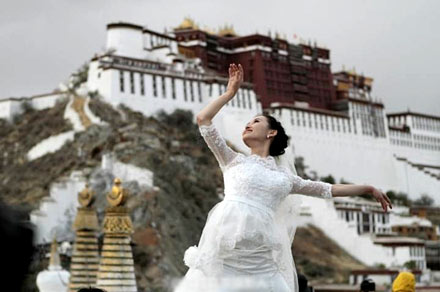
A Chinese bride poses outside the Potala Palace in Lhasa.
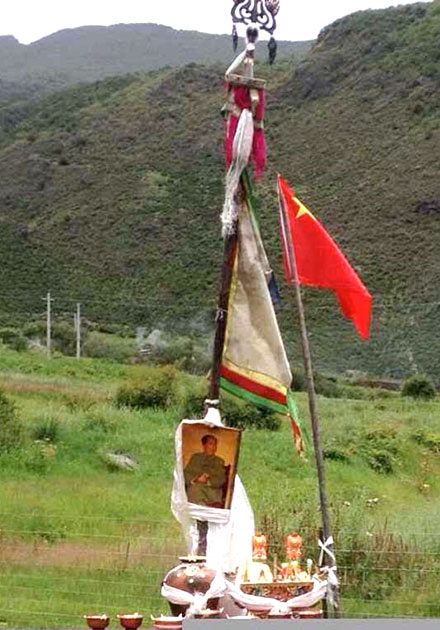
A Mao image on a religious flagpole in Tibet: the image was taken a few weeks ago although exact date is not known. It was passed onto ICT by a Tibetan in contact with Tibetans in Tibet.

AUGUST 11, 2014
Thousands of Tibetans gather to mark enthronement of lama in Kham

Thousands of lay Tibetans and monks gathered to witness the young reincarnation of Penor Rinpoche arriving at the monastery.
In a vivid indication of Tibetan resilience and pride in their religious and cultural identity, tens of thousands of Tibetans gathered at Palyul monastery in Kardze (Chinese: Ganzi) in Sichuan to mark the enthronement of an important reincarnate lama. A three-year old boy who has been recognized as the reincarnation of Penor Rinpoche, the head of the Nyingma tradition of Tibetan Buddhism, was escorted to the enthronement by Khampa horsemen and hundreds of motorbikes and cars. Despite technical challenges, the enthronement was webcast and hundreds of Tibetan monks in south India gathered to watch it.
The official Facebook page of Penor Rinpoche reported during the enthronement: “What was amazing is he is not like other kids. If he was tired, he napped. He never cried once. He just enjoyed everyone coming to visit him.” Tibetans, remembering that when Penor Rinpoche was alive, he had said that he would be reborn in Tibet, circulated photographs on social networking sites such as WeChat, saying that ‘a precious gem’ had returned to Palyul.
Political agenda of inspection team to expose corruption
A team of inspectors has been dispatched from Beijing to the Tibet Autonomous Region to ‘expose corruption’. But the state media also emphasized a more political agenda, which is that the inspectors would also ‘target those who openly speak against central leadership policies’ and fail to implement them. In other words, space is being constricted still further for moderate officials who may seek to voice reasonable opinions and to engage in practical activities to support Tibetans.
A Tibetan from Kham, who is now in exile after a visit to the region, said that the inspection team should ‘seriously investigate the powers of local officials in Tibetan areas to wreck lives’. The Tibetan said that even despite the culture of impunity in Beijing and the systematic political campaigns in Tibet, “Even in Beijing, the central leadership may not be fully aware of the way officials in Tibet act outside the law, and have complete power to destroy people’s lives, in ways that are so damaging to our future and our society.”
A journey to prison through a snowstorm
A Tibetan monk who has recently arrived in exile told ICT of his experiences in prison following a political protest in Ngaba, the Tibetan area of Amdo, in March, 2008. He recalled the moments when he and other monks were dragged from their monastery in the middle of the night to prison. “Outside the prison, there were around 20 paramilitary police with iron pipes and batons waiting for us. We knew what to expect.” The monks were beaten and tortured for several hours, firstly by one group of police, then by two more groups, in shifts. Many of the monks lost consciousness, and suffered serious injuries. The monk also recalled how later they were transferred to a bigger prison. They were loaded in a van and a snowstorm blew up along the way. “All of us monks were forced to push the trucks along in the snow, and our robes were even taken from us and used beneath the wheels of the trucks when the vans got stuck.”

JULY 24, 2014
Tibetan reaction to Chinese Communist Party’s recruitment drive in nomadic areas
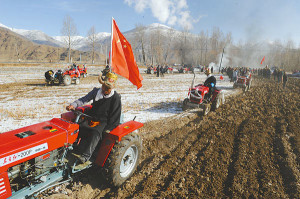 This image from Chinese state media depicts Tibetan farmers displaying Party flags on their tractors.  The CCP is implementing ambitious plans to settle nomads; this image depicts new housing in Darchen, Ngari (Chinese: Ali), in the Tibet Autonomous Region. |
A former nomad from Gansu in eastern Tibet (Amdo) said that he believes control to be the key objective of the campaign to recruit new members of the Chinese Communist Party from nomadic areas, saying: “The economic self-sufficiency, mobility and traditional and religious outlook on life of nomads and farmers in Tibet’s grasslands have made them the most difficult people to integrate into the Chinese state.”
This is reflected in a Xinhua report of on July 8, 2014,[1] which proudly refers to the new measure of establishing one Party office in each village, and outlines the CCP’s grass roots campaign to increase the number of officials in rural areas.
A Tibetan from Lhasa area told ICT about what happened when Party cadres were installed in the village: the cadres, who stayed in family homes, were homesick and found it hard to adapt. One of them was curious about Tibetan beliefs in reincarnation and life after death and asked many questions about the reasons why the family had sent a message to the Dalai Lama when a relative died.
More than 80% of Tibetans live in rural areas across the plateau – grasslands cover about 68% of the 1.22 million square kilometers of the TAR, as well as slightly more than 50% of Qinghai Province’s 720,000 square km, and vast swathes of western Sichuan and Gansu Provinces and northwestern Yunnan Province.
The Xinhua report also included membership statistics, revealing that there are around 270,000 Communist Party members in the Tibet Autonomous Region, with around half from a rural and nomadic background.
A Tibetan who now lives in exile said: “The Party authorities are focusing on the younger generation now, as the elderly generation of CCP members retires. They are particularly looking at ensuring loyalty to the Party authorities in nomadic and rural areas, which are traditionally the most difficult for them to administer.”
[1] http://epaper.chinatibetnews.com/xzrb/html/2014-07/08/content_552769.htm
Why released prisoners suffer from poor eyesight
A Tibetan in exile who was in contact with a recently released Tibetan (who had been arrested for involvement in protest) in eastern Tibet learnt that this person’s eyesight had deteriorated greatly while in custody. He expressed the opinion that this is happening because many Tibetan political prisoners are kept in dark cells and then exposed suddenly to glaring sunlight in the prison compound.

JULY 8, 2014
Tibetans comment on Dalai Lama’s birthday
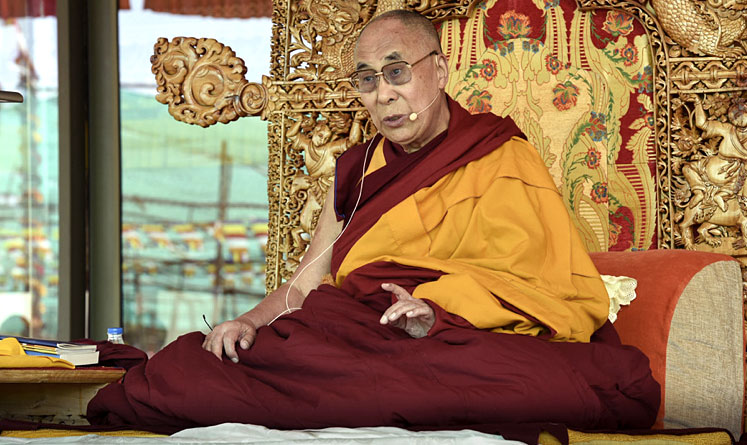
His Holiness the Dalai Lama speaking during the final day of his 33rd Kalachakra Empowerment Preliminary Teachings in Leh, Ladakh, J&K,
India on July 8, 2014. (Photo: Manuel Bauer)
A former Tibetan monk from Gansu, the Tibetan area of Amdo, talked to some Tibetans from eastern Tibet who had just arrived in India about the deeply-felt wish for the Dalai Lama to come home. He said this as a summary of their conversation: “There are two conflicting messages coming from the Chinese government. One is the anti-Dalai Lama campaign. Another is that the door is open for His Holiness to return to China. For the Dalai Lama to return to Tibet – that is 100% the demand of the Tibetan people inside. But there is no particular route that seems apparent to achieving that, because this call strongly counters existing policies. Changing the policies may bring the possibility of the return. Today if China accepts His Holiness the Dalai Lama back to Tibet there are still many Tibetans who will disagree with that, because they know the existing laws and constitution cannot ensure His Holiness’ security under the current situation. Things are changing though and will bring new possibilities of solutions, and in order to do that understanding is key, we have to understand the situation inside.”
A song by a popular singer from eastern Tibet was posted on YouTube to mark the birthday. It featured the artist, who describes himself as “This son of Amdo with unshed tears in his eyes” seated below a thangka with a white khatag as a symbolic offering to His Holiness. He opens his song:
“White cloud
If you fly to India in the South
Take this song there
Six million Tibetans are waiting for you”
Escaped monk reflects on self-immolations
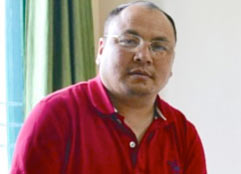

JUNE 20, 2014
Perspectives on self-immolations from Ngaba
A Tibetan from Ngaba said that high levels of militarization were accompanied by a stepped-up drive to attack and undermine Tibetans’ sense of identity, and their culture and religion. He talked about the self-immolations, saying: “These people’s nationalism and sense of patriotism is really beyond death, death can no longer be a threat to them anymore. Sometimes they may make the decision to self-immolate because they consider that sometimes for participation in demonstrations the consequences are worse than death. For such a small action you may be sentenced to ten or 12 years. You have to go through the whole process of interrogation and imprisonment, and there’s always the danger that others are involved if you are forced to name someone. Self-immolation is really painful but then it is over.”
A monk from eastern Tibet said that some Tibetans who survived self-immolation were kept isolated in hospital and remained in critical condition for many months. In one case, he heard that their body was so covered in blisters even doctors could not touch them, and a machine helped to turn them on the bed. He had heard that some self-immolators’ hands or legs had been amputated. “The suffering of Tibetans who survive self-immolation is unimaginable,” he said.
A ‘contradiction between grass and animals’

Bales of fencing in Kham, Tibet, in preparation for enclosing an area of grassland under nomad settlement policies.
More than 80% of Tibetans live in rural areas, and the majority have sustained themselves through a nomadic herder lifestyle, uniquely adapted to the harsh conditions and fragile ecosystem of the Tibetan plateau. But the implementation of Chinese policies to settle Tibetan nomads, and to resettle Tibetans in towns, is now threatening the livelihoods of hundreds of thousands of people and imperilling the Tibetan landscape. It is indicative of the official bias against nomadic pastoralism that in describing this sustainable lifestyle and justifying their reduction of livestock they use the phrase “a contradiction between grass and animals”.

MAY 2014
The crackdown in Lhasa: new propaganda in schools, May, 2014
- A woman in her thirties spoke about levels of surveillance in Lhasa. She said that people sometimes go to bed with the main doors to their houses unlocked. That is because when police come for nightly raids, in a grim routine that has become familiar since 2008, it is preferable to the alternative outcome of a door being broken down.
- A Tibetan teacher from eastern Tibet said: ‘Text books in schools have changed completely with the replacement of Chinese versions under the new ‘bilingual’ policy [which means the mainstreaming of the Chinese language], and withdrawal of Tibetan curriculums such as maths, history, politics and social science and installation of Chinese language, except with Tibetan language and literature texts. Also we are seeing a new wave of aggressive propaganda directed at schoolchildren.”
Communist Party recruitment drive
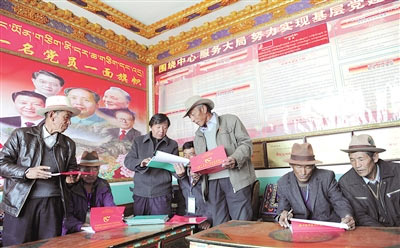 The Chinese government has adopted a strategy of actively establishing Party presence in rural areas as the answer to ‘instability’. This has led to a more pervasive approach to ‘patriotic education’ (now called ‘legal education’, in an attempt to convey a softer approach) and a dramatic increase in work teams and Party cadres in rural as well as urban areas, particularly in the Tibet Autonomous Region. There has also been an increase in well-resourced initiatives in the cultural and social sphere such as competitions where generous prizes are given for reciting details of Party policy. This picture from the state media depicts a ‘village-level officials training workshop’ in Nagchu, the Tibet Autonomous Region, showing local Tibetans studying Party documents with a poster in the background showing that Xi Jinping has been added to the triumvirate of leaders (Deng, Jiang and Hu) clustered around the Great Helmsman. Our Tibetan researcher also noted the emphasis at such meetings of encouraging Tibetans to join the Communist Party.
The Chinese government has adopted a strategy of actively establishing Party presence in rural areas as the answer to ‘instability’. This has led to a more pervasive approach to ‘patriotic education’ (now called ‘legal education’, in an attempt to convey a softer approach) and a dramatic increase in work teams and Party cadres in rural as well as urban areas, particularly in the Tibet Autonomous Region. There has also been an increase in well-resourced initiatives in the cultural and social sphere such as competitions where generous prizes are given for reciting details of Party policy. This picture from the state media depicts a ‘village-level officials training workshop’ in Nagchu, the Tibet Autonomous Region, showing local Tibetans studying Party documents with a poster in the background showing that Xi Jinping has been added to the triumvirate of leaders (Deng, Jiang and Hu) clustered around the Great Helmsman. Our Tibetan researcher also noted the emphasis at such meetings of encouraging Tibetans to join the Communist Party.


